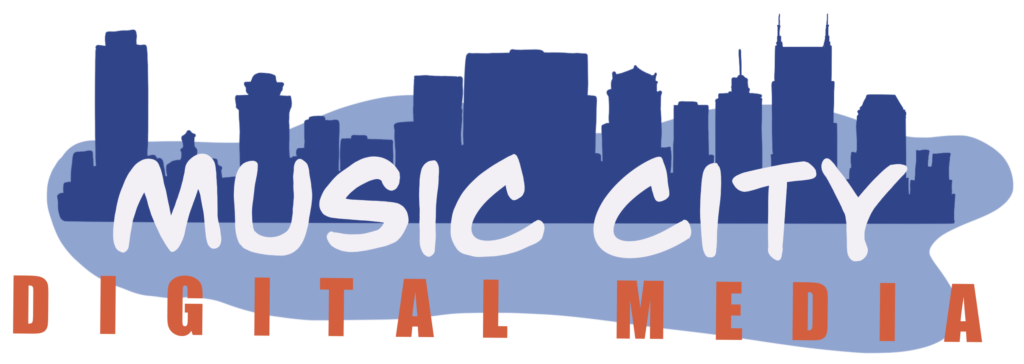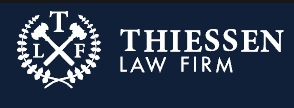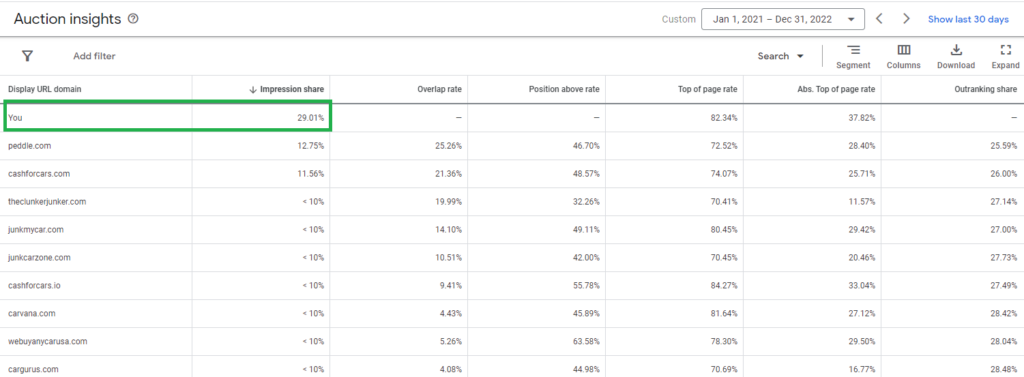


Account history starts in the third quarter of 2020, we are looking at approximately 3 years of continuous account history. The account appears to have grown over this time with the top of the funnel producing 296,000 impressions resulting in 16,100 users being brought to the website. That’s coming out to a 5.43% click-through rate, which immediately tells me that this account is primarily using search campaigns or search in conjunction with some display or Performance Max to generate what is considered an excellent click-through rate.
For reference we like to see a minimum 2% rate and conversion rate with all things related to Google ads. What is also interesting, possibly a strange coincidence or an indication of a misconfigured conversion tracking setup, which is tracking page views instead of bottom of funnel conversion actions, we see a 5.42% conversion rate. Assuming these conversions are phone calls, emails and form submits this would be an excellent bottom of funnel conversion production ratio. Average cost per conversion, whatever those may be, are coming out to $107 per conversion action with a $7.66 send average cost per click.
All of this data seems well within industry standards, the average cost per conversion at the account level seems on the more affordable side of the equation. Typically when we’re talking about $10,000 plus retainers on the back end we would see a slightly higher cost per acquisition and I wouldn’t be it all surprised to see CPAs over $300 once all the accounting is done in terms of final cost per acquisition for these clients.


121M
1.02M
131,000
.084%
12.54
$3.24
$25.18
Campaign structure supports my earlier hypothesis that the account was heavy in search campaigns. We see seven of eight active campaigns are search campaigns with one Performance Max campaign. Of note is that we have a variety of bid strategies in play for what appear to be different types of criminal cases.
Typically when it comes to lead generation we are trying to generate the maximum number of leads from a given Market in a given time. Target cost per acquisition bid strategies for instance will throttle ad spend in an account such that it may diminish the quality of the leads that your ads are being served to in the first place. It’s for that reason that we typically maximize conversion bid strategy for most lead generation search campaigns. We have further broken down some specific examples using alternative bid strategies which we agree with or have recommendations for.
Further information that we’d like to share with you is as follows: We have observed that All of the search campaigns are opted into the Google search partners network. This sounds like a good idea in theory, however in reality, it is actually not a good idea and tends to run up Impressions and Clicks, however, not generate bottom of funnel conversion results. Also, we see that ad rotation optimization is not enabled for some campaigns, ad rotation optimization allows the system to automatically keep track of all of the permutations of ads and ad copy and automatically run the ones that perform best. This is an excellent feature of the system and one that should always be enabled to get the best, especially out of search campaigns. We do see some inconsistencies with location targeting , primarily Harris County being targeted in some campaigns but not all. We also see Texas as a whole state being targeted for intoxicated manslaughter. as well as some more precise radiuses for DWI exact match and DWI phrase match campaigns using enhanced cost per click bid strategies. Ad scheduling is set to run all day except for the P Max Campaign which has an 8:30 a.m. to 11:45 p.m. schedule. Finally we only see bid adjustments for ad schedules on two campaigns and device targeting enabled for all devices.
Brand Campaign – Target Impression , This campaign is doing an excellent job of dominating on very specific branded search terms. This is the one instance that I’d recommend continuing with your target impression share strategy.
P Max – Max Conversion Bid Strategy, Bottom of funnel conversion production is the one thing that Performance Max is not good at. Performance Max takes advantage of all aspects of the Google Marketing platform including search, display, youtube, email and finally discovery networks. This all-of-network approach basically means that most of your ads are going to be ran as display ads and we are utilizing a carpet-bombing strategy, we typically see lower click-through rates with this type of campaign and therefore typically set bid strategies to maximize clicks.
Enhanced CPC Campaigns , We recommend pausing these campaigns or at the very least changing the bid strategies to a Smart Bidding Strategy like Maximize Conversions
Demographic data seems to be consistent with the vertical. We do have a minimum amount of 18 to 24 year old traffic with the vast majority representing the 25 to 64-year-old age range. We do see a slight bias towards males as well as a slight bias towards top income earners. It may be worth a test in order to gauge the quality of clients coming to you from ads, but you might want to test eliminating the lower 50% of income earners from targeting in the first place. This may shift your impression share towards the higher income earners and therefore more affluent clients from the beginning.
In terms of audience targeting there seems to be a slight preference for nightlife Enthusiast at a 10% conversion rate however that is just barely above the threshold to be statistically significant.
Contact Music City Digital Media to take your campaigns to the next level.
Device data indicates that the majority of Impressions clicks and conversions are all coming from mobile devices. click-through rates across all devices are roughly the same between 4 and 6%. Click rates are mostly the same between desktop and mobile devices however tablets are showing a clear deficiency in production compared to the other two device types. Cost per conversion on tablets is averaging $239 per conversion action which is the highest in the account and you can generate at least twice the number of conversions for the same money on mobile devices.
Contact Music City Digital Media to take your campaigns to the next level.
We see multiple active conversion actions in the account, primarily form submissions which are active in reporting conversions as well as a GA-4 Texas trial attorney PPC request submission. it is worth noting that the second conversion action is marked as a secondary conversion action which means the system is not actively optimizing for these actions. We also see phone call conversions coming from ads as well as the website.
Ad scheduling data is fairly straightforward, however location data is presenting some interesting pieces of information. On the ad scheduling front there tends to be a propensity of conversion actions to happen between the hours of 7:00 a.m. and 7:00 p.m. Monday through friday. This is typical with most B2B and legal operations in our experience. It may make sense to experiment with ad scheduling that limits the time that your ads are served from 6:00 a.m. to say 10:00 p.m. Saturday through friday. This has the effect of shifting the bell curve of Impressions and clicks to times of days and days of week which users are more likely to result in a conversion action and therefore increase overall conversion rate on the account.
Location data also presents Some contrasting targeting options. For instance we see many campaigns are targeting locally within a 20 mile radius around the business location however we also see county level targeting with the criminal campaign, P Max campaign, intoxicated manslaughter campaign in another criminal categories campaign. We also see the intoxicated manslaughter campaign is also targeting the State of Texas. To us it seems like the targeting methodology here has been deployed haphazardly unless there’s some other element of information that we are missing which would justify this location structuring.
Contact Music City Digital Media to take your campaigns to the next level.
Bid adjustments are only applicable to Target cost per acquisition, Target return on ad spend, maximize clicks bid strategies. Maximize conversions ignores these adjustments to field the maximum number of opportunities possible for your given budget.

Keyword data is very straightforward in the account and we do see some modified broad match keywords that have been in use at some point in the past. just as a reminder, modified broad match is no longer in use and it looks like all keywords using modified broad match have been paused at this point. Remaining active keywords in the account are related specifically to your vertical and also the case types that you are pursuing. There’s a couple of best practices that should be followed in terms of regular optimization practices for any Google ads account. We do see many broad match phrase match types in the account. generally we advise against these as even though they have been improved by Google they still catch far too many spurious searches whose ad spend would better be spent elsewhere.
Contact Music City Digital Media to take your campaigns to the next level.
Plenty of conversion actions in the account Forms and Phone Calls seem to be the top mediums of conversion. One observation is that there are very different click through conversion windows on the conversions. Some are 1 day while others are 90.

Contact Music City Digital Media to take your campaigns to the next level.
The account commanded the majority of the search market over the lookback period with 29%. Primary Competitors are Peddle.com with 12.75% and cashforcars.com with 11.56%. We also see the clunkerjunker.com, junkmycar.com, Carvana and car gurus.

Not surprisingly the top performing ad sets are all responsive search ads within their respective campaigns. It does look like there is one branded expanded search ad that was doing especially well for you however it looks like that it was paused once expanded search ads were terminated from Google ads and no longer editable. Ad strength ranges from poor to average, there’s no ad that registers as good or excellent, we would recommend increasing your overall ad strength which will thereby increase at Rank and improve your position in the Google ads auction process. click through rates on existing ads range from 4 to 14%. I like to see a minimum of 2% click-through rate for account level as well as ad level performance. Conversion rates are doing even better than that ranging anywhere from 8 to 17%. Assuming these are valid conversion actions, that is excellent performance.
Shifting our view to enabled assets on the account we see site links, call outs, structured Snippets and finally call extensions enabled and producing clicks on the account.